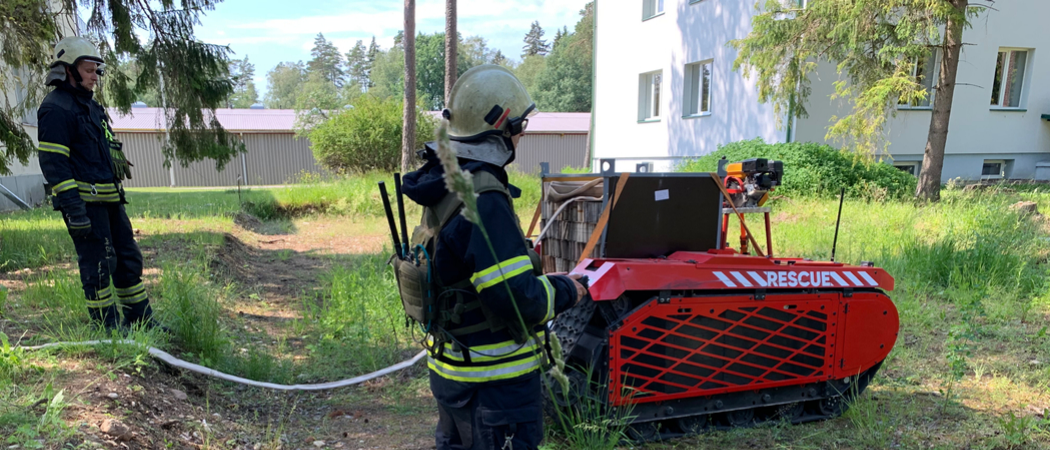Tallinn’s Milrem Robotics is developing adaptable firefighting robots that can use ‘Plug’n Play payloads’

After Notre Dame Cathedral in Paris caught fire in April, a robot called Colossus helped save much of the historic structure by braving conditions deemed too dangerous for human firefighters.
The Notre Dame fire was ``the first big-visibility usage of robots in firefighting,’’ says Mart Noorma, director of science and development at Tallinn-based Milrem Robotics, which is testing robotic tracked vehicles with Estonia’s firefighters.
As well as being more resilient, robotic firefighters could prove to be more versatile than their human counterparts. Noorma says Milrem’s joystick-controlled modular unmanned ground vehicle (or UGV) can be quickly adapted for a variety of tasks, including spraying intense fires, unreeling bulky hoses and evacuating injured parties, using “Plug’n Play payloads”. The UGVs can also be equipped with cameras and sensors to assist with the evaluation of hazards before humans are sent in. Like Colossus, Milrem’s UGV is designed to combat blazes in conditions that would be too dangerous or difficult to access for human firefighters, including burning buildings and marshy forest areas.
Robots roll up to the front line
As automation technology advances, firefighting teams around the world are recruiting their first robots. Shark Robotics, the French company that makes Colossus, says its robots have been deployed in Marseille, Bordeaux and other French towns, and they have been sent across the border to the Belgian city of Charleroi.
In Japan, Mitsubishi Heavy Industries has developed a firefighting robot system as part of a five-year project led by the nation’s Fire and Disaster Management Agency (FDMA). The system, designed specifically to respond to energy and industrial infrastructure disasters, was inaugurated this summer in the city of Ichihara, near Tokyo, according to the Yomiuri Shimbun newspaper. The FDMA plans to deploy the robots to fire departments in industrial zones across the country.
Elsewhere in Asia, the city of Nanchang, southwest of Shanghai, has a fleet of extinguishing robots built by Italy-based EmiControls, while the Mumbai Fire Brigade is reported to have deployed a firefighting robot in June, though it was criticized as inefficient, according to the Times of India.
Indeed, firefighting robots may need time to fit in. “The challenge is still how to integrate these robotic tools into [firefighters’] standard procedures,” Noorma says. “So they have to re-develop their concepts of operations to incorporate the new capabilities that robotic firefighters bring.”
Milrem is testing its UGV together with the Estonian Rescue Board, which is responsible for firefighting and rescue operations in the country. Conducted on September 25, the latest test simulated an airplane crash in a forest. For Ivar Frantsuzov, a logistics expert with the Estonian Rescue Board, a key takeaway from the exercise was the need for more lighting on the UGV during rescue operations. The team members “need more light – all around” the vehicle when performing rescues in dark conditions, he says.
Milrem is using such feedback to further develop the UGV system, Noorma says. “It’s all about prototyping and development of concepts, together with potential end-uses, and at the same time doing scientific research,” says Noorma, who is also a professor of space and defense technology at the University of Tartu.
Stronger, faster, lower
While Milrem’s basic UGV weighs 1,600 kilograms and can carry 750 kilos, its track propulsion means the weight is spread out over the supporting surface, allowing the machine to operate in marshy or other potentially unstable environments. “The pressure on the ground is three times less than a human foot,’” Noorma explains.
Just 115 centimeters high, the robotic vehicle can reach speeds of 20 kilometers an hour, enabling it to dispense hose or tote equipment more quickly than human firefighters, meaning a faster start to the task of extinguishing the fire. The UGV can operate for up to 90 minutes in electric mode and up to 12 hours using its hybrid diesel-electric set-up. The vehicle is designed “especially for warehouse, tunnel and wildfire extinguishing,” according to Milrem.
Milrem’s ongoing research includes investigating how to increase the autonomy of the robots while keeping ultimate control in human hands, work that is being carried out in partnership with the University of Tartu and Tallinn University of Technology (TalTech) and is supported by almost 2 million euros in funding from the European Union. “The level of autonomy of these vehicles is constantly growing,” Noorma says. “This vehicle is designed to be remotely operated and the operator can be either human or an autonomous navigation system.”
Milrem, which was founded in 2013 with a primary focus of developing robotic UGVs for military purposes, is using what it has learned from defense applications to develop systems for commercial use, targeting especially firefighting, mining and agricultural uses. Its military UGVs have attracted the interest of the Netherlands, the U.K. and the U.S., as well as Estonia, which has deployed the robot vehicles in Mali in support functions for its troops there.
In time, advances in robotics and autonomous systems should mean more and more humans can step out of harm’s way. “In most sectors, end-users don’t have any clear understanding of how these instruments will be used in five to 10 years,” Noorma says. “It’s a kind of disruptive innovation.”



 A unique international forum for public research organisations and companies to connect their external engagement with strategic interests around their R&D system.
A unique international forum for public research organisations and companies to connect their external engagement with strategic interests around their R&D system.